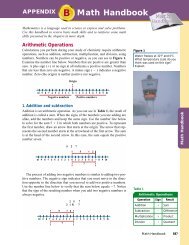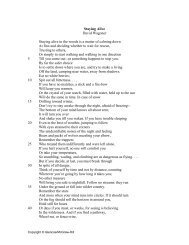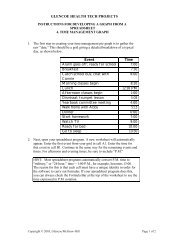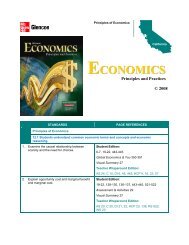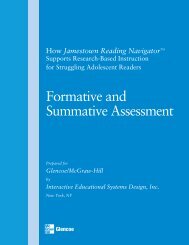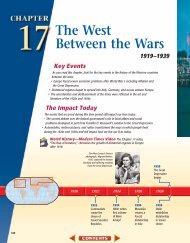Vocabulary - Research
Vocabulary - Research
Vocabulary - Research
Create successful ePaper yourself
Turn your PDF publications into a flip-book with our unique Google optimized e-Paper software.
eferences<br />
J a m e s t o w n R e a d i n g N a v i g a t o r<br />
VOCABULARY References<br />
Allington, R. L. (2006). What really matters for struggling<br />
readers: Designing research-based programs (2nd<br />
ed.). New York: Pearson Education.<br />
Anderson, R. C., & Freebody, P. (1981). <strong>Vocabulary</strong><br />
knowledge. In J. T. Guthrie (Ed.), Comprehension and<br />
teaching: <strong>Research</strong> reviews (pp. 77–117). Newark, DE:<br />
International Reading Association.<br />
Askov, E. N., & Kamm, K. (1976). Context clues: Should<br />
we teach children to use a classification system in reading?<br />
Journal of Educational <strong>Research</strong>, 69, 341–344.<br />
Baker, S. K., Simmons, D. C., & Kame’enui, E. J. (1998a).<br />
<strong>Vocabulary</strong> acquisition: Instructional and curricular basics<br />
and implications. In D. C. Simmons & E. J. Kame’enui<br />
(Eds.), What reading research tells us about children with<br />
diverse learning needs (pp. 219–238). Mahwah, NJ: Lawrence<br />
Erlbaum Associates.<br />
Baumann, J. F., Kame’enui, E. J., & Ash, G. E. (2003).<br />
<strong>Research</strong> on vocabulary instruction: Voltaire redux. In J.<br />
Flood, D. Lapp, J. R. Squire, & J. M. Jensen (Eds.), Handbook<br />
of research on teaching the English language arts<br />
(2nd ed., pp. 752–785). Mahwah, NJ: Lawrence Erlbaum<br />
Associates.<br />
Beck, I. L., & McKeown, M. G. (1991). Conditions<br />
of vocabulary acquisition. In R. Barr, M. L. Kamil, P.<br />
Mosenthal, & P. D. Pearson (Eds.), Handbook of reading<br />
research (Vol. 2, pp. 789–814). Mahwah, NJ: Lawrence<br />
Erlbaum Associates.<br />
Beck, I. L., McKeown, M., and Kucan, L. (2002). Bringing<br />
words to life: Robust vocabulary instruction. New<br />
York: The Guilford Press.<br />
Beck, I. L., Perfetti, C. A., & McKeown, M. G. (1982).<br />
Effects of long-term vocabulary instruction on lexical access<br />
and reading comprehension. Journal of Educational<br />
Psychology, 74(4), 506–521.<br />
Biancarosa, C., & Snow, C. E. (2006). Reading next: A<br />
vision for action and research in middle and high school<br />
literacy: A report to Carnegie Corporation of New York<br />
(2nd ed.). Washington, DC: Alliance for Excellent Education.<br />
Retrieved January 8, 2007, from http://www.all4ed.<br />
org/publications/ReadingNext/ReadingNext.pdf.<br />
Blachowicz, C. L. Z., & Fisher, P. (2000). <strong>Vocabulary</strong><br />
instruction. In Kamil et al. (Eds.), Handbook of reading<br />
research (Vol. 3, pp. 503–523). Mahwah, NJ: Lawrence<br />
Erlbaum Associates.<br />
Brett, A., Rothlein, L., & Hurley, M. (1996). <strong>Vocabulary</strong><br />
acquisition from listening to stories and explanations of<br />
target words. Elementary School Journal, 96(4), 415–<br />
422.<br />
Buikema, J. L., & Graves, M. F. (1993). Teaching students<br />
to use context cues to infer word meanings. Journal of<br />
Reading, 36(6), 450–457.<br />
Carney, J. J., Anderson, D., Blackburn, C., & Blessing, D.<br />
(1984). Preteaching vocabulary and the comprehension<br />
of social studies materials by elementary school children.<br />
Social Education, 48(3), 195–196.<br />
Coxhead, A. (n. d.). The academic word list. Accessed<br />
July 10, 2007, from http://www.vuw.ac.nz/lals/research/<br />
awl/.<br />
Cunningham, A., & Stanovich, K. E. (1998, Spring/Summer).<br />
What reading does for the mind. American Educator,<br />
8–15.<br />
Davidson, J., Elcock, J., & Noyes, P. (1996). A preliminary<br />
study of the effect of computer-assisted practice<br />
on reading attainment. Journal of <strong>Research</strong> in Reading,<br />
19(2), 102–110.<br />
20<br />
Dole, J. A., Sloan, C., & Trathen, W. (1995). Teaching<br />
vocabulary within the context of literature. Journal of<br />
Reading, 38(6), 452–460.<br />
Duin, A. H., & Graves, M. F. (1987). Intensive vocabulary<br />
instruction as a prewriting technique. Reading <strong>Research</strong><br />
Quarterly, 22, 311–330.<br />
Freyd, P., & Baron, J. (1982). Individual differences in<br />
acquisition of derivational morphology. Journal of Verbal<br />
Learning and Verbal Behavior, 21, 282–295.<br />
Gipe, J. P. (1978–1979). Investigating techniques for<br />
teaching word meanings. Reading <strong>Research</strong> Quarterly,<br />
14, 624–645.<br />
Graham, S., & Perin, D. (2007). Writing next: Effective<br />
strategies to improve writing of adolescents in middle and<br />
high schools: A report to Carnegie Corporation of New<br />
York. Washington, DC: Alliance for Excellent Education.<br />
Retrieved February 12, 2007, from http://www.all4ed.<br />
org/publications/WritingNext/WritingNext.pdf.<br />
Graves, M. (2006). The vocabulary book: Learning and<br />
instruction. New York: Teachers College, Columbia University.<br />
Graves, M. F., & Hammond, H. K. (1980). A validated<br />
procedure for teaching prefixes and its effect on students’<br />
ability to assign meaning to novel words. In M. L. Kamil<br />
& A. J. Moe (Eds.), Perspectives on reading research<br />
and instruction: Twenty-ninth yearbook of the National<br />
Reading Conference (Vol. 29, pp. 184–188). Washington,<br />
DC: National Reading Conference.<br />
Hafner, L. E. (1965). A one-month experiment in teaching<br />
context aids in fifth grade. Journal of Educational <strong>Research</strong>,<br />
58, 471–474.<br />
Harris, A. J., & Jacobson, M. D. (1982). Basic reading<br />
vocabularies. New York: MacMillan.<br />
Heise, B. L., Papalewis, R., & Tanner, D. E. (1991). Building<br />
base vocabulary with computer-assisted instruction.<br />
Teacher Education Quarterly, 18(1), 55–63.<br />
Heller, J. H., Sturner, R. A., Funk, S. G., & Feezor, M. D.<br />
(1993). The effect of input mode on vocabulary identification<br />
performance at low intensity. Journal of Educational<br />
Computing <strong>Research</strong>, 9(4), 509–518.<br />
Higgins, N. C., & Cocks, P. (1999). The effects of animation<br />
cues on vocabulary development. Reading Psychology,<br />
20(1), 1–10.<br />
Jenkins, J. R., Matlock, B., & Slocum, T. A. (1989). Two<br />
approaches to vocabulary instruction: The teaching of<br />
individual word meanings and practice in deriving word<br />
meaning from context. Reading <strong>Research</strong> Quarterly,<br />
24(2), 215–235.<br />
Kame’enui, E. J., & Simmons, D. (1990). Designing instructional<br />
strategies for the prevention of academic<br />
learning problems. Columbus, OH: Merrill.<br />
Kamil, M. L. (2003). Adolescents and literacy: Reading<br />
for the 21st century. Washington, DC: Alliance for Excellent<br />
Education. Retrieved February 17, 2007, from http://<br />
www.all4ed.org/publications/AdolescentsAndLiteracy.<br />
pdf.<br />
Kim, H. S., & Kamil, M. L. (2004). Adolescents, computer<br />
technology, and literacy. In T. L. Jetton & J. A.<br />
Dole (Eds.), Adolescent literacy research and practice (pp.<br />
351–368). New York: The Guilford Press.<br />
Malone, R. A., & McLaughlin, T. F. (1997). The effects<br />
of reciprocal peer tutoring with a group contingency on<br />
quiz performance in vocabulary with seventh- and eighthgrade<br />
students. Behavioral Interventions, 12(1), 27–40.




